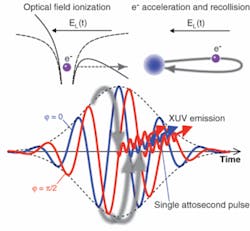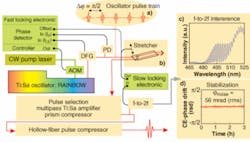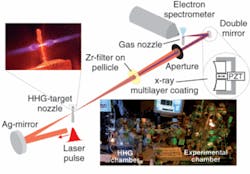Attosecond sources: Few-cycle laser amplifiers bridge the gap between femto- and attosecond ranges
ANDREAS ASSION, GABRIEL TEMPEA, ELEFTHERIOS GOULIELMAKIS, AND MATTHIAS UIBERACKER
Attosecond science has emerged as one of the most topical fields of fundamental research.1 Predicted more than a decade ago, attosecond (1 as = 1018 s) pulse generation relies on laser-atom interactions in the strong field regime and can be understood via an intuitive semiclassical model.2 An outer-shell electron is detached from the laser-irradiated atom and accelerated in the optical field (see Fig. 1). When the sign of the electric field reverses, the energetic electron has a certain probability of recombining with the parent atom. The recombination process is radiative, leading to emission of energetic soft-x-ray photons. If the driving pulse lasts many optical cycles, the emission spectrum will consist of isolated odd harmonics of the laser frequency corresponding in the time domain to a train of attosecond soft-x-ray pulses.
FIGURE 1. High-order harmonic generation with few-cycle pulses can be described by a semiclassical three-step model (top). If the carrier-envelope (CE) phase amounts to π/2, cutoff radiation can emerge from two recombination events separated by half an optical cycle (bottom; red line). However, for CE-phase values equal to 0, the electric field has only one maximum. Consequently, cutoff radiation emerges in a single attosecond pulse (bottom, blue line). (Courtesy of A. Baltuska, Vienna U. of Technology)
To generate an isolated attosecond pulse, soft-x-ray emission must be confined to one optical cycle (approximately 2.5 fs) of the driving pulse. Once this condition is fulfilled, either one or two attosecond pulses will be generated, depending on the carrier-envelope offset phase (CE-phase quantifies the relative position of the carrier field with respect to the envelope), which calls for the stabilization of this parameter.
Isolating a single attosecond pulse
Several techniques have been devised to confine harmonic generation to a single optical cycle, but these are still under development.3, 4 Furthermore, while circumventing the need for single-cycle driving pulses, these methods either increase the complexity of the experimental apparatus or impair the conversion efficiency of the process.
The simplest implementation of isolated attosecond pulse generation relies on using few-cycle driving pulses.5 Here, radiation in the high-energy end (cutoff) of the harmonic spectrum is inherently confined to one optical cycle. Routine generation of CE-phase-stabilized submillijoule 5 fs pulses is straightforward with specially engineered Ti:sapphire laser systems.
The pulse-to-pulse CE-phase drift introduced by these chirped-pulse multipass amplifiers (CPA) is slow and quite small so the phase drift of the amplified pulses can be canceled out by a feedback loop, provided that seed pulses with constant CE phase are used.6 Gain narrowing prevents the generation of few-cycle pulses directly from a CPA. This inherent drawback can be overcome by spectrally broadening the output pulses by nonlinear propagation (such as in a gas-filled hollow waveguide).
Few-cycle pulses
In a CE-phase-stabilized few-cycle amplifier system, a broadband chirped-mirror-based oscillator generates sub-6 fs pulses at 800 nm with a spectral width of more than 300 nm (see Fig. 2). Owing to the broad spectral distribution, a monolithic setup can measure the CE frequency, fCE, through difference-frequency generation (DFG).7 In a self-referencing stabilization scheme the phase difference between fCE and a fraction of the repetition rate fR is measured, providing the error signal for the oscillator CE-phase-locking electronics. Locking fCE is achieved by feedback-controlling the pump power of the oscillator using an acousto-optic modulator.
FIGURE 2. In a CE-phase-stabilized multipass amplifier system, the amplifier is seeded with ultrashort, spectrally ultrabroadband pulses generated with the Femtolasers RAINBOW oscillator. The CE frequency is stabilized to 1/4 of the repetition rate leading to CE-phase slip of the oscillator pulses of λ/2 (a). The CE-phase drift of the amplifier (c), is compensated with a prism integrated in the pulse stretcher (b). The CE-phase noise acquired for eight laser shots, measured for 3 h, is 56 mrad rms (d). Finally, the CE-phase-stabilized pulses are compressed down to less than 5 fs FWHM at 400 µJ by means of a hollow-fiber dispersive-mirror compressor. (Courtesy of Femtolasers Produktions)
Setting fCE = 1/4 fR results in a constant phase slip of λ/2 between two consecutive pulses; therefore, each fourth pulse of the oscillator pulse train has the same CE phase. Before amplification the oscillator pulses are stretched to 10 ps with a monolithic SF 57 glass block. After the pulse selection, which reduces the repetition rate to 1 kHz, only pulses with the same CE phase are selected for seeding the last passes of the amplifier. A prism sequence compresses the amplified pulses to 25 fs at 800 µJ. The amplified pulses are spectrally broadened in a hollow-core waveguide filled with neon and subsequently, a set of ultrabroadband dispersive mirrors compress the 400 µJ pulses to sub-5 fs.
A collinear interferometer measures the CE-phase drift at the input of the hollow-fiber compressor, producing an interference spectrogram, and the CE-phase evolution is retrieved from the change of the interference pattern. The signal generated by the slow-locking electronics controls the position of a piezo-actuated prism integrated in the monolithic stretcher. The cut-off frequency of the piezo prism displacement is more than 200 Hz, fast enough to compensate the CE-phase drift of the amplifier. With this stabilization scheme a CE-phase noise of 56 mrad (rms) over three hours is routinely achieved.
Several innovations ensure long-term CE-phase stability: a chirped-mirror-based oscillator is less sensitive to phase-noise coupling mechanisms as compared to its prism-based counterpart; the monolithic DFG-based fCE measurement setup is robust, insensitive to beam-pointing drifts, and easy to operate; the monolithic stretcher is nearly CE-phase-drift free; a comparatively low stretching factor leads to a compact prism compressor, which dramatically reduces the CE-phase drift as compared to grating compressors; and instabilities in the operation of the oscillator and phase detector are avoided by means of decoupled oscillator and amplifier CE-phase-stabilization loops.9
Attosecond-pulse measurement
Compared to femtosecond laser pulses, attosecond pulses are particularly fragile and their temporal characterization is more complex. The dominant technique for characterization of these pulses is the so-called attosecond streak camera. This technique borrows its basic ideas from conventional streak cameras in which an electron replica of an unknown optical pulse is generated when the latter impinges onto a photosensitive cathode. A strong temporally varying electric field between the plates of a capacitor is then used to spatially deflect or “streak” the electrons before they reach a photosensitive screen. Time is therefore mapped onto space, allowing decoding of the temporal structure of the electron and, thereby, the optical pulse.
Similarly, in the attosecond streak camera, a soft-x-ray attosecond pulse generates a replica in terms of an electron pulse through photoionization in an atomic gas. The electronic pulse inherits the temporal structure of the soft-x-ray pulse and can now be influenced by an electric “streaking” field. However, to guarantee high resolution, released electrons are not streaked by a field produced in a macroscopic capacitor, but instead by the hyperfast and ultra-intense field of laser light. This field does not modify the trajectories in space, but rather the final kinetic energy of the released electrons, which can be measured accurately with an electron spectrometer.
To implement attosecond pulse measurement, soft-x-rays in the range of 100 eV are generated by gently focusing the few-cycle laser pulses into a quasi-static gas cell filled with neon (see Fig. 3).10 A quasi-monolithic double-mirror assembly focuses the soft-x-rays and the laser beam into a second neon gas target. Electrons ejected in the polarization direction of the laser are collected by a time-of-flight electron spectrometer. While scanning the delay between the few-cycle laser pulse and the attosecond pulse in the range of about ±10 fs, a series of electron spectra is recorded and finally combined into an attosecond streaking spectrogram (see Fig. 4). Oscillatory shifts of the energy of the detected electrons as a function of the delay corresponds to the vector potential (temporally integrated electric field) of the laser pulse.
FIGURE 4. A streaking spectrogram consists of a series of electron spectra recorded at different delay settings. The data represent the number of detected neon 2p photoelectrons (binding potential: 21.56 eV) in false-color coding. An improved electron spectrometer with higher collection angle recorded this measurement within 60 minutes. Analysis revealed a duration of 4.7 fs FWHM for the few-cycle laser pulse and a duration of 170 ± 10 as FWHM for the soft-x-ray pulse.
Few-cycle waveform-controlled fields generated from state-of-the-art Ti:sapphire laser sources are enabling tools for the generation of isolated attosecond pulses. However, the temporal resolution potentially achievable in applications is not exclusively related to the soft-x-ray attosecond pulse duration. It is even further enhanced when the attosecond pulses are used in conjunction with few-cycle laser pulses for the study of extreme ultrafast phenomena in a pump-probe scheme with resolution on the order of 100 asenabling, for the first time, direct experimental investigations of electronic phenomena inside atoms (see www.laserfocusworld.com/articles/314415). The real-time observation of an Auger decay and also electron tunneling in atoms constitute some of the first feats of attosecond science, clearly demonstrating the tremendous potential this research field holds for the future.11, 12
REFERENCES
1. P.B. Corkum et al., Nature Physics 3, 381 (2007).
2. P.B. Corkum, Phys. Rev. Lett. 71, 1994 (1993).
3. G. Sansone et al., Science 314, 443 (2006).
4. T. Pfeifer et al., Opt. Lett. 31, 975 (2006).
5. R. Kienberger et al., Nature 427, 817 (2004).
6. A. Baltuska et al., Nature 421, 611 (2003).
7. T. Fuji et al., Opt. Lett. 30, 332 (2005).
8. Patent pending (NISTAC, KSU) (2006).
9. Ch. Li et al., Opt. Lett. 31, 3113 (2006).
10. M. Schultze et al., New J. Phys. 9, 243 (2007).
11. M. Drescher et al., Nature 419, 783 (2002).
12. M. Uiberacker et al., Nature 446, 627 (2007).
ANDREAS ASSION is product manager, Amplifier Department, and GABRIEL TEMPEA is product manager, Optics, at Femtolasers Produktions, Fernkorngasse 10, A-1100 Vienna, Austria; e-mail: [email protected]; www.femtolasers.com. ELEFTHERIOS GOULIELMAKIS and MATTHIAS UIBERACKER are postdoctoral researchers at the Max Planck Institut für Quantenoptik, Hans Kopfermann Strasse 1, 85748 Garching, Germany; www.attoworld.de.



